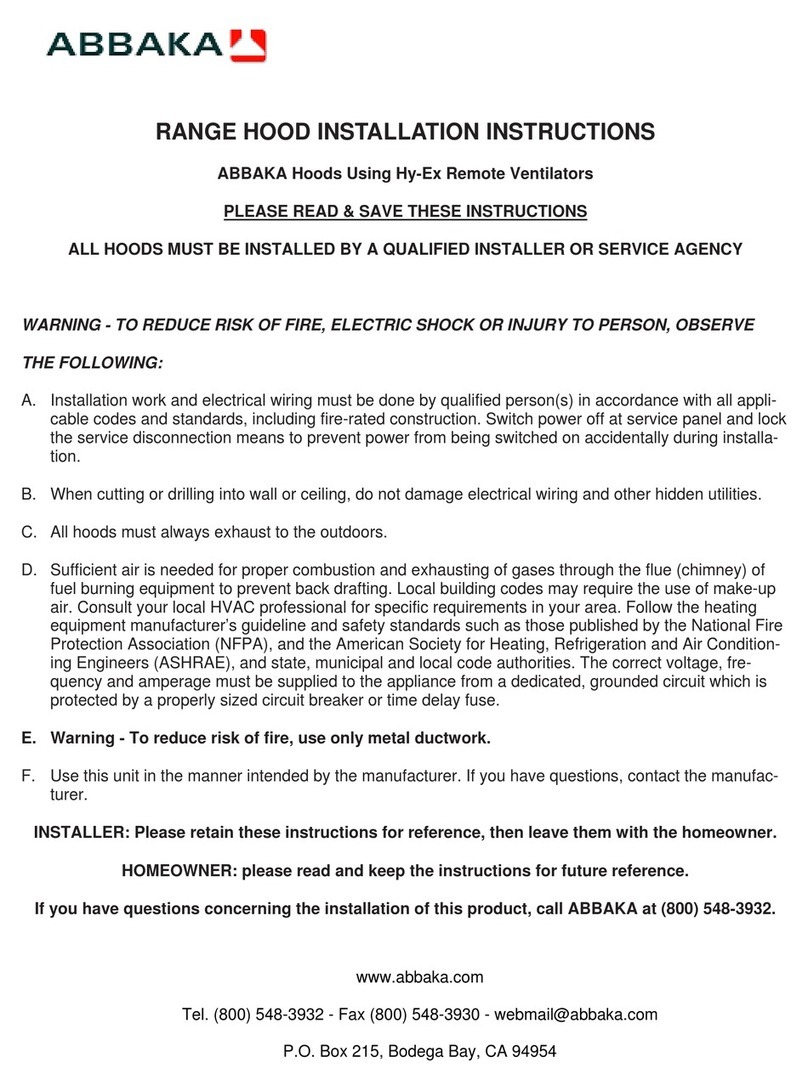
8
1. Protect the cooktop with a furniture pad or consider
building a worktop straddling the counter. Center
and square the hood to the actual location of cook-
top. Lift in straight line to ceiling and trace outline of
stack onto ceiling. Lower hood to rest position. Alter-
nately, use a plumb line and "project" the four cor-
ners of the stack to ceiling and mark the position.
2. IMPORTANT: DO NOT LIFT HOOD BY RAILS.
3. With a sheetrock knife, cut opening in ceiling 1/16”
larger than previously traced stack outline. Should
ceiling not be perfectly level, stack top can be re-
cessed into cut out eliminating possible shadow line.
Note: Wall hoods with centered stack (Luna &
Quantum models) are supplied with ceiling bracket
to position and “plum” stack top.
4. NOTE: After installation is completed, any gap be-
tween ceiling opening and hood stack can be filled
with paint-ready acrylic caulking and painted or
framed with molding. Optional decorative ceiling cover plate is offered for difficult to patch wood ceil-
ing.
5. Wall mounted hoods may be attached to the wall at the stud position (see figure above). In some
cases, the hood may need to be attached to a plywood backing previously installed in wall behind
hood.
6. Drill mount holes through solid back wall of hood cabinet (use cobalt drill bit on stainless hoods) 2"
up from base of hood on center with at least two studs. Drill upper attachment hole as close to hood
centerline and as high up from hood bottom as possible.
7. Lift hood into position and secure firmly to wall studs or backing with lag bolts and lock nuts.
8. If overall height of hood positions bottom below recommended clearance above cooking surface,
excess stack may be cut off. Any ragged cut line or material discoloration from cutting, can be hid-
den by recessing stack top into sheetrock.
NOTE 1: Stainless Steel may be cut in several ways - POWER JIG SAW using carbide blades
designed specifically for ferrous or hardened metals (24 teeth per inch), ANGLE GRINDER or
heavy duty angle drill using an abrasive type aluminum oxide, diamond edge, or carbide wheel.
If using a jigsaw, the cutting process will be slow, generate a lot of heat, and may require sev-
eral saw blades. "Blueing" or discoloration of the stainless steel may occur during cutting.
NOTE 2: When drilling use cobalt drill bits for stainless. Use 1/8" bit for pilot hole and enlarge as
needed with "Step-Drill" or progressively larger bits.
Hanging
Wall Mounted Hoods
Wall Stud Upper Wall
Attachment
Point
Hood Base
Wall
Attachment Points
Ceiling




























